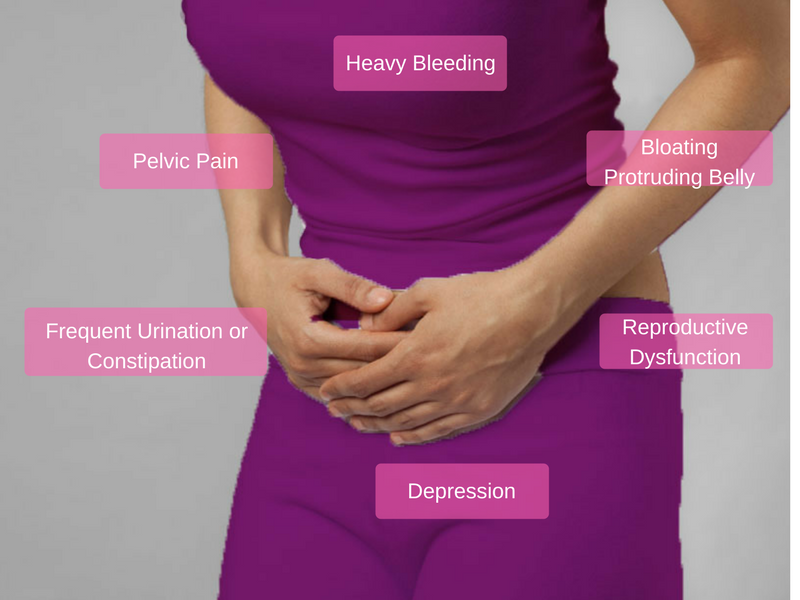All You Need To Know About Fibroids: Symptoms, Treatment & Diagnosis

This article is about understanding fibroids better and demystifying it as much as possible. Let’s take it from what it actually is, to its possible causes, predisposing factors, diagnosis and treatment options. The good news is that it is a treatable condition.
What is Fibroid?
Fibroids are tumours, they are the most frequently (20-50%) seen tumors of the female reproductive system and are also benign in nature, in other words, they are not cancerous.
They are also known as uterine myomas, leiomyomas, or fibromas, and they are developed from smooth muscle cells and fibrous connective tissue in the uterus. Fibroids are particularly common during the childbearing years, and an estimated 30-77 percent of women will develop it during those years even though only one-third will be large enough to be detected by a health care provider during a physical examination.
Causes
Because fibroids can be such a nagging problem, women often ask what the causes are when faced with possible or actual diagnosis of uterine fibroids.
Women have another concern on what can be done to prevent or slow down the growth of uterine fibroids, but answering that will require identifying the real causes of the condition; but the actual and specific cause is something researchers are still learning about; even though a number of risk factors have been identified.
READ ALSO: What Causes Polycystic Ovary Syndrome (PCOS), Symptoms And Treatment
Risk Factors
See below, a number of risk factors associated with developing fibroids:
1. Race: For some reason, the condition is more common with black women than their white counterparts
2. Genetics: if your grandma or mum, or another female in your family has had fibroids, you may have them too.
3. Having Less Than Two Children: Scientists agree that the more children a woman has, the less likely it is that she will develop 4. fibroids. researchers do not know exactly why that is.
4. Dietary Habits: Not consistently eating fruits and vegetables might increase your risk; researchers found that at least 2 servings of fruit a day, especially citrus fruits, was associated with a lowered risk of uterine fibroids. You should consider eating more fruit therefore.
5. Lifestyle: An American Journal Of Epidemiology in 2012 published a study where it linked the use of hair relaxers with increased risk of uterine fibroids. In the case of young Black girls, their research shows that there is an association between African-Americans girls who use straightening and relaxer hair oils and the onset of their menstrual cycle.
Stressful major life events such as a divorce, loss of a spouse or child could be a risk factor, the stress is thought to lead to changes in hormone levels that encourage the development of fibroids.
Other risk factors may include; exposure to childhood abuse, starting menstruation early, vitamin D deficiencies, and prenatal exposures.
Symptoms
Not all women who have fibroids will show symptoms, while some may have only mild symptoms, others will have more severe, disruptive symptoms.
Symptoms may include one or a combination of the following:
- Heavy or prolonged menstrual periods
- Abnormal bleeding between menstrual periods
- Pelvic pain (caused as the tumor presses on pelvic organs)
- Frequent urination
- Low back pain
- Pain during intercourse
- A firm mass, often located near the middle of the pelvis, which can be felt by the physician.
READ ALSO: Uterine Fibroids, Fertility & Pregnancy: What Every Woman Should Know
In some cases, the heavy or prolonged menstrual periods, or the abnormal bleeding between periods, can lead to iron-deficiency anemia, which also requires treatment.
Diagnosis
Fibroids are most often found during a routine pelvic examination. This, along with an abdominal examination, may indicate a firm, irregular pelvic mass to the physician.
In addition to a complete medical history and physical and pelvic and/or abdominal examination, diagnostic procedures for uterine fibroids may include blood tests, hysteroscopy, MRI, transvaginal ultrasound, and X-ray.
Treatment for fibroids
In women whose fibroids are large or are causing significant symptoms, treatment may be necessary. Treatment will be determined by your health care provider based on your overall medical history, your expectations after treatment, severity of your symptoms among other factors.
It is important that women do not resort to unsafe methods to treat fibroids, since there are effective medical treatments for same. Treatment options include medication, surgery, or a minimally invasive treatment option known as uterine fibroid embolization.
Photo Credit: Google


